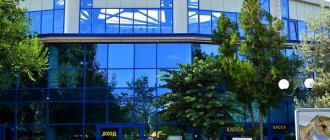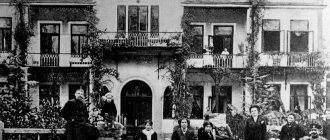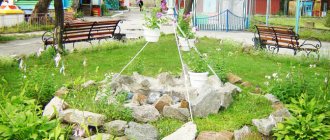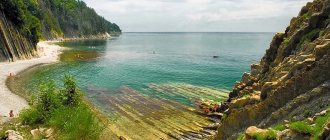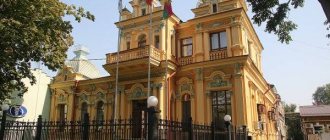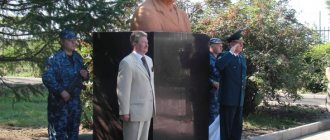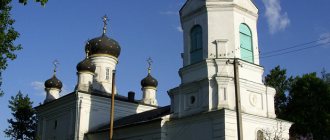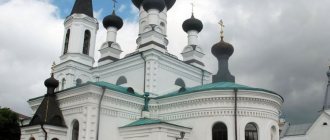History of the emergence of Simferopol and general information
The city of Simferopol is the center of Crimea in every sense. The geographical position is almost in the middle of the peninsula, transport - it is from here that roads and railways run in all directions. And, of course, administratively, Simferopol is the capital of the Republic of Crimea. By the standards of modern times, this is a fairly young city; in 2014 it will celebrate its 230th birthday.
Panoramic view of the city
The city in the form in which we now know it was born by the will of the Russian Empress Catherine II the Great. It was she who ordered Prince Grigory Potemkin-Tauride in 1783 to build a city in the center of the Tauride province. The location for the city was chosen near the Salgir River, near the Tatar village of Ak-Mechet. In 1784, the construction of the city began; Catherine herself gave it a name, calling it in her characteristic manner, in Greek. Simferopol means a gathering city. And this perfectly conveys its essence to this day. The first Saturday of June is considered the city’s birthday, since it was at the beginning of June 1784 that the first buildings were laid. However, in reality the city is much older. After all, it is located on the site of the ancient capital of the Scythian state - Scythian Naples.
Fortification of Naples
Kebir-Jami Mosque
The date of construction of the mosque is the beginning of the 16th century. It is believed that the white lime-covered walls of the facade of the oldest building in the city at one time gave it its name - Ak-Mosque (see above). Kebir-Jami is the main mosque of Crimea, which looks very simple in appearance. After the revolution it continued to function, but was closed in the post-war years. The building housed a bookbinding workshop. After the Crimean Tatars deported during the war returned to the peninsula, the mosque was returned to them. Its restoration began in 1991 and lasted almost two decades.
Kebir-Jami Mosque
The mosque complex houses the spiritual administration of the Muslims of Crimea, the residence of the mufti, a madrasah and a library with literature in the Crimean Tatar language.
Address: st. Kurchatova, 4. Directions: by buses 8, 11, 47, 57 and 78 to the stop “Ul. Lenin". The mosque is open to the public except during prayer times.
Climate and ecology of Simferopol
Simferopol is located at the end of the steppe zone of Crimea, closer to the mountains. Therefore, its climate is dry-steppe and foothills. There is a very mild winter here, during which the townspeople see snow for only a week in total. Snowfall on New Year's Day is considered a real miracle. Summer here is long and quite hot. Of course, there are years when these statements can be questioned, but still, a cold and rainy summer in Simferopol is an infrequent occurrence. Sometimes it lasts almost 9 months, as it did in 2012. When summer began in April and ended in October, throughout this period the temperature did not drop below +20 degrees Celsius.
According to weather forecasters, the average temperature in the city in summer is +25.3 °C, and in winter +0.2 °C. In fact, in winter there are no frosts below 15 °C, although this does happen occasionally. There are, although a little less sunny days a year in Simferopol than on the South Coast, but still a lot. According to the same weather forecasters, this is 2469 hours of sunshine per year. Precipitation occurs more often in spring or autumn; in summer, rain is quite rare, but can be very strong, more like tropical downpours. It hails quite often.
In February and early March, the windy season comes to the city. The wind reaches 20-25 m/s and can blow for several days in a row. Everything blooms in Simferopol by mid-March. And trees such as almonds can bloom from the end of February.
The environment in the city is quite good. There are not so many enterprises that can pollute the atmosphere. Of course, the air here is more polluted than on the seashores, but the concept of “smog” is little known to city dwellers. The Salgir River, around which the city is located, is now quite clean. There was a time when various sewage and waste were poured into it, but now this is prohibited. It is home to fish and many wild ducks live on its banks all year round, which the townspeople happily feed.
Salgir in May
Botanical phenomena
In the courtyard of a five-story building at st. Frunze, 30 you can see a botanical phenomenon - a five-trunked chestnut tree, whose age is approaching two hundred years. In 1829, the famous doctor and scientist Fyodor Milgausen, who lived nearby, planted seven chestnut fruits in one hole - according to the number of members of his family. Five of them were accepted, which eventually grew together, forming a common trunk with a diameter of more than five meters. At a height of two meters the trees disperse.
Five-trunk chestnut
Another unique tree can be seen in the Simferopol Children's Park. The age of the giant oak, whose trunk diameter exceeds six meters, is estimated at 6–7 centuries. The oak has its own name - “Hero of Taurida”. According to some researchers, this particular oak is the prototype of Pushkin’s “oak near Lukomorye”. In development of this version, a “Glade of Fairy Tales” with characters from Pushkin’s fairy tales was created in the Children’s Park.
Oak "Bogatyr of Taurida"
Population of Simferopol
Historically, many different nationalities live in Crimea. Simferopol is a direct reflection of the entire Crimea in this matter. Russians, Ukrainians, Crimean Tatars, Armenians, Greeks, Georgians, Bulgarians and other nationalities live here. People are very friendly both to each other and to visitors. There is no nationalism in the city. The only “but” is the relationship of the Crimean Tatars with other peoples. There are about 10% of them in the city and sometimes there are some disagreements between them and other residents of the city. This is due largely to the policies pursued by their leaders. Ordinary Crimean Tatars are always very friendly and loyal to other nationalities. Russians make up the majority of the population in the city, about 67%, Ukrainians - 21%. The total population of Simferopol is almost 363 thousand people; according to the 2001 census, this is even 363.6 thousand people. Now, unfortunately, the mortality rate prevails over the birth rate. For every 100 people, only 12 are born and 13 die. The average age of the population in Simferopol is 43 years. At the same time, pensioners and children predominate; the working population is approximately one third.
The level of education in the city is quite high. All higher educational institutions of Crimea are concentrated here, such as the Taurida National University, the Crimean Medical University, the Agrarian Academy, and the Crimean Environmental University of Resort Construction. Therefore, young people can get an education quite easily. Culture in the city is also at a fairly high level. Of course, as elsewhere, there are different segments of the population with different cultural levels, but the intelligent population of all ages predominates. The hobbies of Simferopol residents are determined by the environment; they love tourism and history. There are many hiking clubs, caving organizations and historical societies. International knightly tournaments are regularly held here. For children, since the times of the USSR, the Small Academy of Sciences - MAN - has been operating.
Knight Tournament
Botanical Garden named after. Bagrova
The botanical garden belonging to the Crimean Federal University is often called Salgirka. It was created in 2003 on the basis of the garden art park of the same name that previously existed here. On an area of 30 hectares you can see the entire flora of the peninsula - maples, birches, spruces, Crimean pines, Lebanese cedars, chestnuts. Of particular value are the patriarchal trees - oaks, plane trees, yew and pine trees, preserved from the end of the 18th century.
Botanical Garden named after.
Bagrova The garden has a Rosary, Siringary (lilac nursery), Iridarium, Coniveretum (coniferous nursery), Labyrinth, and Cascade of reservoirs.
Former Vorontsov's mansion
One of the university's scientific buildings is the former Vorontsov's mansion, the entrance to which is guarded by stone lions (as in his famous Alupka palace).
Address: Academician Vernadsky Ave., 2. The Botanical Garden is open from 7 a.m. to 8 p.m. Upon prior request, you can book an excursion. Travel to the Tavria Tourist Base stop by buses 49 and 65 or trolleybuses 4, 6, 15 and 16.
Districts and real estate of Simferopol
Although Simferopol is the capital of Crimea, in terms of area it is not the largest city on the peninsula. Its area is 130 sq. km, which is less than the area of Sevastopol. Officially, the city is divided into 4 districts, these are: Zheleznodorozhny district, central district, Kyiv district and the GRES village. But in fact, this is a very conditional administrative division. There are many more districts and they differ greatly from each other, both in the standard of living of the population, its culture, and in real estate prices. If we consider each administrative district separately, we get the following picture:
central District
This area covers the southern part of the city. It borders the other two districts near the Salgir River, not far from the main post office.
Salgir, new building
In addition to the center itself, the central district of the city includes many other microdistricts: both residential and industrial. Several of the largest streets in Simferopol belong to the central district: st. Sevastopolskaya, Kirov Ave., 60 Years of the USSR Ave.
Kirov Avenue opposite Lenin Square
If you look at the central region towards the southwest, then there is the edge of the city and the exit towards Sevastopol. This is where Sevastopolskaya Street ends, which unites several microdistricts of the city. The most extreme of them is Novoromanovka. There is a fairly developed social structure here, there is a school, a kindergarten, small shops and a micro market. The houses here are represented by both high-rise buildings and the private sector. Prices for apartments are not much different from prices on other outskirts of Simferopol. Thus, a one-room apartment in a standard building can be bought for 25-30 thousand dollars, depending on the condition. A two-room apartment will cost 35-45 thousand, and a three-room apartment up to 55 thousand dollars. There is no luxury housing in this area of the city. New buildings too. Transport links are normal; buses and minibuses go to almost any area of Simferopol. There is a trolleybus that will take you to the Moscow Ring.
Behind Novoromanovka there is the village of Chistenkaya, although it does not belong to the city, but residents still consider it part of it. Here there are mainly private houses, the price of which starts from 75 thousand dollars and reaches 200-250 thousand, depending on the area and size of the plot. You can see real villas and castles.
In addition to Novoromanovka, the Fontana district is located in the same direction. The standard of living and housing prices in these neighborhoods are approximately the same. However, Crimean Tatars predominate in Fontany. There are several new houses here that were built especially for them. There is a mosque and a Tatar school in the area.
The next microdistrict is Zalesskaya. It got its name thanks to Zalesskaya Street, around which it is actually located. There are many nine-story buildings, five-story Khrushchev-era buildings and the private sector in the area. One of the city’s hospitals, the 7th City Hospital, is also located here. It includes a clinic that serves all surrounding neighborhoods and the 2nd city maternity hospital. In addition, on Zalesskaya there is a children's clinic, several kindergartens, schools and even 3 vocational schools. There are also 2 large grocery supermarkets conveniently located here: Furshet and ATB, as well as the Zalessky market. You can buy food and things at the market; there are many small shops and cafes and eateries concentrated around it. Zalesskaya is attractive for motorists. One of the two auto parts markets in Simferopol is located here. In addition, on Zalesskaya there is a park for children, there are many attractions and a good playground.
Children's playground in Trenev Square
Transport links to this area are the best; there are many trolleybuses, buses and minibuses. To the north of the microdistrict there is a coniferous forest, which borders on the other side with another microdistrict of the central region of Simferopol - Pnevmatika.
Pnevmatika is one of the youngest microdistricts of Simferopol. This residential area is only 25 years old. The houses here are all nine-story and this is practically the only real residential area in the city.
Microdistrict Pnevmatika
Prices for apartments here are slightly higher than in Novoromanovka, and approximately the same as in Zalesskaya. A two-room apartment now costs about 45 thousand dollars, a one-room apartment costs about 30 thousand, and a three-room apartment costs up to 70 thousand dollars. The layout of all houses in the microdistrict is approximately the same. There are two new buildings where apartment prices are slightly higher. Two more houses are 70-90% ready. Prices for new buildings are estimated at about 800-950 dollars per 1 square meter. Socially, Pnevmatika is a fairly average area. There is one school here, but no kindergarten. In recent years, three groups have been operating at the school. The microdistrict got its name from the Pnevmatika enterprise, which is located here. It was for this enterprise that the microdistrict was created in the late 80s of the last century. Now the enterprise is not operating at full capacity, so the majority of residents work in other places.
View of the city from Pnevmatika
The microdistrict is also distinguished by the fact that it is located on a hill, as if apart from the main city. Before development, the old city landfill was located here. However, now nothing reminds me of her. One of the advantages of Pneumatics is the forest area, where residents go out en masse for picnics on weekends and holidays. Transport links here are quite good. There is one trolleybus and many buses and minibuses to all parts of the city. There is an indoor food market, a car showroom, and an ATB supermarket that recently opened. The road that leads to the neighborhood is simply disgusting. In terms of the crime situation, the area is quite calm.
Below, Pnevmatika street borders. Russian, which on one side intersects with D. Ulyanov Street, and on the other borders with the old cemetery and Kozlov Street. In this square, also formed by the street. Sevastopolskaya, private houses and five-story buildings predominate. On D. Ulyanov Street there are 4 kindergartens and several schools, including the Linguist school, which is a paid school with full board and in-depth study of languages. Housing prices here depend on the location of the house and its condition, the level is approximately the same as in Pneumatics. The private sector costs from $80 thousand and above per house. At the end of the street D.Ulyanov on the street. The Selpo hypermarket is located in Sevastopolskaya.
In addition, the Central District of Simferopol includes the so-called Old Town and Petrovskaya Balka. These are the oldest districts of Simferopol with very narrow, dirty streets and a predominance of private houses. Without exaggeration, these areas can be considered urban slums, both in terms of infrastructure and crime. All the gopniks of Simferopol are mainly from here. Housing prices here are significantly lower than in other areas. The houses have no amenities or gas. The price for a one-room apartment starts from 8-10 thousand dollars. The area is located on a hill and it is better not to appear here at night.
The rest of the Central District is the center itself. It starts from the Central Market and ends at Sovetskaya Square.
Office center on Sovetskaya Square
Housing located in the center is more expensive than in other areas. For new buildings this is about 1000-1100 dollars per square meter, and for secondary housing it is about 50 thousand for a one-room apartment and 100 thousand for a three-room apartment. All government bodies, theaters, and a circus are located here. The main street is Kirov Avenue. The central square of the city, Lenin Square, is also located here. The center of Simferopol differs from the bustling and noisy centers familiar to residents of megacities. It is compact, green and cozy.
Simferopol center
Zheleznodorozhny district
It is called so because its center is the railway station.
Vokzalnaya Square
However, the area is quite large. Among the residential microdistricts, the Moskolets district especially stands out. This is a prestigious area located at the exit from Simferopol to the Moscow highway. Apartments here are slightly cheaper than in the center. You can buy a one-room apartment for 40 thousand dollars, and a three-room apartment for 75-85 thousand.
Moskoltso
There are quite a lot of new buildings of different classes, as well as luxury housing in park areas. Here is the large Moskoltso market and the Privoz market for wholesale and retail sales of vegetables and fruits. On the outskirts of the city, the Auchan hypermarket recently opened. Many schools, kindergartens. There are villages of luxury cottages, where the price of a house starts from 180 thousand dollars. A prestigious Ukrainian gymnasium is also located here. Transport links are excellent. Towards the station there is the 6th city hospital and a large perinatal center, which recently opened on the basis of a diagnostic center. The largest private clinic in Simferopol, Genesis, is also located here. The largest park in Simferopol, Gagarinsky Park, is located in the Zheleznodorozhny district. This is a very large green area on the banks of Salgir and two ponds. The recently opened Ice Palace is located in Gagarinsky Park. There is also an eternal flame and a memorial complex there.
But in the Zheleznodorozhny district there is another slum and criminal area of Simferopol - st. Lesya Ukrainka. It is dominated by the private sector, has very bad roads and is tense in the evenings. There is also a large residential microdistrict in the Zheleznodorozhny district, this is the district of Marshal Zhukov, popularly called Zhuchka. There are nine-story buildings here, there is a school and kindergartens. The area is also provided with supermarkets. However, there are not the best transport connections and overall distance from the center. The area is located on a hill, somewhat to the side of the city. Next to it is a large industrial zone and the Simferopol correctional colony. Apartment prices here are quite average. A one-room apartment costs about 30 thousand dollars, and a three-room apartment costs about 50 thousand.
Kyiv district
The Kiev district of Simferopol also covers several areas that are completely different in nature. Here is the Simferopol Bus Station, Tauride University with the Botanical Vorontsov Park, as well as the outskirts of the city towards Feodosia Svoboda and Zagorodny, and towards Alushta - Maryino.
Maryino, green city
Maryino is in turn divided into Bespalova and the Hospital Town, which is located near the oncology hospital. Bespalov Street is quite uncomfortable, there are bad roads and distance from transport links. The houses are predominantly of old construction. The same situation is in the area of Vorovskogo Street.
Below Vorovskogo Street, view from the cliff of Naples
There are a lot of fatal accidents on Vorovsky. The 1st maternity hospital of Simferopol is also located here. There are a lot of new high-rise buildings near the bus station, the prices for apartments in them are the same as in Moskolets.
Bus station area
In addition, the largest and most expensive indoor market in Simferopol, Kuibyshevsky, is located in the Kievsky district. Next to which there is a Children's Park. This area is considered an elite area, and apartments here cost the same as in the city center. The Svoboda and Zagorodny districts are located at the exit from Simferopol.
Outskirts of Simferopol
The prices for apartments are the same as in the Pnevmatika microdistrict. The infrastructure is developed, there are many gardens and schools. The Republican Children's Hospital is also located nearby.
Settlement GRES
The GRES settlement is located outside the administrative border of the city, but relates directly to it. This is a small microdistrict, which is located on the road in the Evpatoria direction, not reaching the airport. It has its own school, a fairly good warm kindergarten, small shops and a large industrial zone across the highway. The state district power station itself and the reinforced concrete plant are located in the industrial zone. There are also many different other enterprises and warehouses there. Because of the pipes, the power plant is considered the dirtiest area of the city. The residents here keep themselves quite apart, one might say, like a kind of clan. It is difficult for strangers to take root in this area. Apartments here are cheaper than in the city. One-room from 25 thousand, two-room from 30 thousand and three-room from 40 thousand. Not long ago, a hotel was opened next to the state district power plant, which increased the number of jobs for residents and enlivened the life of the neighborhood.
Suburb of Simferopol
Holy Trinity Cathedral
In the second half of the 19th century. The majestic Holy Trinity Cathedral was built on the site of the Greek Orthodox Church.
Holy Trinity Cathedral
In the 30s of the XX century. the temple's property was confiscated and it was closed. It was planned to house a children's boarding school in the building. However, the local Greek community, part of which had Greek citizenship, managed to achieve the re-opening of their temple in 1934. Moreover, after the destruction of the Alexander Nevsky Cathedral, the Holy Trinity Church received the status of Cathedral. In 1946, it was headed by Archbishop Luka of Crimea (see above). In 1996, his relics were transferred to the cathedral and are now his relic, kept in a silver shrine. And the cathedral itself is sometimes called after him.
Relics of Luke of Crimea
Another valuable shrine is the “Sorrowful” icon of the Mother of God.
She is famous for the fact that in 2004, on the feast of the Dormition of the Virgin Mary, her dim, barely visible image was renewed and sparkled with fresh colors. In 2002, the Synod of the Ukrainian Orthodox Church transformed the Holy Trinity Cathedral into a convent of the same name, and temporarily (until the reconstruction of the Alexander Nevsky Cathedral) transferred the status of the Cathedral to the Peter and Paul Church.
Address: st. Odesskaya, 12. Opening hours: 9–18. The St. Luke's Museum is open Wednesday - Sunday from 9 a.m. to 4 p.m. Ticket price – 70 rubles. Travel: by trolleybuses 4, 9 and 12 or minibuses 48, 54, 62, 63, 68–70, 73, 80, 83, 85, 86, 91, 99, 114, 115 and 118 to the stop “Silpo”, formerly called "Lenin Square".
Infrastructure of Simferopol
It is difficult to say whether Simferopol lives up to the capital, judging by its infrastructure. The roads in the city are being repaired in a very spontaneous and chaotic manner. As a result, those streets that were completely renovated several years ago are gradually falling into disrepair. Basically, in the center and on major streets, the condition of the roads is quite tolerable, which cannot be said about the outskirts and the old city. City authorities try from time to time to improve the situation, but they do not always succeed.
Traffic jams in the city are quite rare. Despite the fact that the streets are quite narrow and there are a lot of cars, traffic is organized correctly, and even during rush hours there are almost no traffic jams in the city. Public transport is represented by trolleybuses and minibuses. Communication between almost all areas in the city is excellent. Of course, trolleybuses do not travel everywhere, but minibuses fill this gap. You can easily get from one end of the city to the other within one hour, including the waiting time for the minibus. There are plenty of parking lots in the city for personal transport, so problems with where to leave your car, as a rule, do not arise even in the very center of the city.
Intercity trolleybus
As already noted in the information on districts, there are quite a lot of schools and kindergartens in the city. Of course, like everywhere else, there are not enough kindergartens, but this problem is not too acute. Usually, almost all children get a place in kindergarten if they get on the waiting list at the city executive committee on time. There are also enough hospitals in Simferopol. There are district clinics and outpatient clinics. Not a very good invention is family medicine, which is common in some “experimental” areas of the city. When one doctor treats both adults and children.
The housing stock in the city is quite varied. There are many standard houses built in the 80s and 90s, a smaller percentage of new buildings, many five-story buildings and very old and dilapidated housing stock. Payments for utility services are divided between services. So Simferopol residents pay for gas to Gorgaz, for water - to Vodokanal, for heat - Krymteplokomunenergo, for electricity - Krymenergo, and for an apartment in the housing office. The average price tag for a two-room apartment, inhabited by 4 people, with an area of 45 square meters. meters reaches 80-90 dollars for utilities along with electricity.
Holy surgeon
Crimeans and Simferopol residents are rightfully proud of their outstanding fellow countryman, known in religious circles as St. Luke. From 1946 until his death in 1961, he headed the city Cathedral with the rank of Archbishop of Crimea. Luke was one of those rare clergy who fully fulfilled the commandments of Christ. All his life he selflessly helped the poorest and most vulnerable people, not differing too much from them in his modest attire. He recognized the authority of Christ alone and was principled and independent in his judgments and actions. In pre-war Soviet times, the future archbishop was repeatedly arrested and spent 11 years in exile. It would seem that this was a fairly common fate of a priest during the Soviet period.
Saint Luke
But this amazing personality also had an extremely interesting secular hypostasis.
Valentin Voino-Yasenetsky is an outstanding Soviet surgeon, one of the founders of Soviet purulent surgery, Doctor of Medical Sciences, Stalin Prize laureate (the only clergyman).
At the beginning of the war, Voino-Yasenetsky from Krasnoyarsk exile sent a telegram addressed to Kalinin offering the Red Army his services as a highly qualified surgeon. The request to temporarily interrupt the exile was granted, and Voino-Yasenetsky, appointed chief surgeon of the Krasnoyarsk evacuation hospital, saved many wounded Soviet soldiers. And in 1942 the church authorities entrusted Bishop Luke with the leadership of the Krasnoyarsk diocese.
After the military hospital moved to Tambov in 1944, Doctor Voino-Yasenetsky continued his active medical work, at the same time heading the local diocese of the Russian Orthodox Church. Under his leadership, about a million rubles were collected and transferred to the needs of the front. In 1946, the archbishop, who had not fully served his exile, became a laureate of the Stalin Prize of the first degree for the development during the war of innovative methods of surgical treatment of purulent wounds. He donated two-thirds of the prize, which was huge at that time, to post-war orphanages that were in dire need of it.
After his death, the archbishop was canonized by the Ukrainian Orthodox Church in 1995. And the Russian Orthodox Church canonized its bishop as a new martyr and confessor in 2000. Krasnoyarsk Medical University bears his name. In 2013, a feature film “Cure Fear” was shot about Luka Krymsky. In 2015, the documentary film “Healer Luke” was shown on Channel One. In the Holy Trinity Cathedral of Simferopol, where the bishop served, there is a small museum of his (see below).
Enterprises and work in Simferopol
It is difficult to say which profession is now most in demand and well paid in the city. There are many banks and their branches in Simferopol, so financiers are definitely well employed. Lawyers have a lot of work too. These two specialties have average salaries in the region of $450. Among the large enterprises in the city there are: Selma, Pnevmatika, Beer and Soft Drinks Plant "Crimea", a cognac factory, Krymteplitsa, State District Power Plant, Concrete Concrete Products, a vodka factory, a Fiolent plant, Krymprodmash, a pasta factory, a confectionery factory, a dairy factory, a bakery, an Essential Oil enterprise, a leather goods factory and other. There are also several industrial zones where wholesale warehouses and production facilities are located.
Selma plant
Simferopol is the center for supplying the entire Crimea with both food and industrial goods. There are several construction hypermarkets here: New Line and Epicenter. There is also a Cash and Carry Metro Center here. Construction companies are widely developed. There are several of them in the city and they all have existing construction projects. These are Vladograd, Consol, Soyuzstroytekhnologiya and Monolit. Wages for construction workers range from $300 to $600 per month.
It is quite easy to get a job in Simferopol, but for available jobs the salary is up to $300. Teachers, doctors and other government workers receive even less. There are many office centers housing various medium and small companies. Their areas of activity are quite different, so the salary level is also different. Qualified accounting and management services are the most well paid.
A lot of people are engaged in small trade. This leads to the constant emergence of spontaneous markets on the city streets, which local authorities are struggling with. This state of affairs is due to the fact that all places in the main markets of the city have been purchased and distributed among certain people.
Crimean Tatars most often work as minibus taxi drivers. This is their area in which it is difficult to meet drivers of other nationalities. Those Crimean Tatars, often women, who have higher education, work as doctors and teachers. In these areas, Slavs also became less common. The employment center is engaged in the employment of the population in the city; twice a year, job fairs are held on the central Lenin Square, which allow many people to find good jobs. There are also staffing and recruiting agencies in the city.
Naples Scythian
In 1827, Crimean Tatar antiquities collector Kata Giray drew attention to a cart from the outskirts of the city with slabs on which were images of horsemen and Greek inscriptions. It turned out that they were found in stone and limestone quarries. Excavations began there, quickly revealing to archaeologists the ruins of the almost forgotten ancient city of Scythian Naples.
Ruins of Scythian Naples
The most valuable is the reconstructed mausoleum of the Scythian king Skilur, clearly visible in the photograph.
Here the archaeologists had a rare stroke of luck: the burial itself reached them intact. It contained a lot of gold jewelry, most of which are now exhibited in Moscow and St. Petersburg museums. Subsequently, excavations were periodically carried out in this area both in the 19th and 20th centuries. The most productive work was done in 1945–50. under the leadership of archaeologist Schultz. It was then that the above-mentioned mausoleum, fortress gates, and rock crypts were opened. In the post-Soviet years, the ancient settlement was abandoned, and only in 2011 it received the status of a Museum-Reserve.
The historical and archaeological reserve of Naples Scythian is an open-air museum with an ever-growing exhibition. After all, only a small part of the ancient city has been excavated, and every year the reserve expands its borders. In the demonstration design of the discovered artifacts, only stone, clay and straw in tune with the ancient era are used.
Address: st. Archaeological, 1. Opening hours: from 10 to 18 hours daily, except Monday. Ticket price – 200 rubles. Directions: by minibus 4 (from the railway station), 85 (from the center) and 108 (from the market) to the stop “Ulitsa Tarabukina”.
Crime
The general situation in the city is quite calm. High-profile incidents are quite rare. Over the past few years, there have been no high-profile murders in the city. Of course, they exist, like everywhere else, but these are all domestic or drunken showdowns. There are waves of burglaries across areas. Thieves are caught quite rarely. Custom cases also remain unsolved. So, four years ago, a local businessman was shot at point-blank range in Pnevmatika. The killer fled on a bicycle and has not yet been detained.
Murder of a businessman. Photo by K. Mikhalchevsky
The crime situation varies across city districts. The most unsafe areas are considered to be the Old Town and the street. Lesya Ukrainka. Gagarinsky Park is also unsafe at night. Robberies happen there quite often. Before the holidays, the number of pickpockets increases. So, last year, before the New Year, a wave of thefts of wallets in toy stores swept through the city. However, in general, Simferopol is quite safe and calm for life. In residential areas you can feel safe on the street and at night. There are no maniacs or serial killers.
Karaite kenasa
Crimea is one of the habitats of a small people - the Karaites. In everyday life, being close to the Turks, they, however, profess a special branch of Judaism. Karaite houses of worship are called kenasa (accent on the last syllable). They are found in several Crimean cities, but Simferopol is considered the most beautiful. This kenasa was built at the end of the 19th century, next to the former prayer house, which could no longer accommodate the growing Karaite community. The beautiful building, combining elements of Byzantine, Moorish and Gothic architectural styles, was built with funds raised by the community.
With the establishment of Soviet power, the Karaite community in 1922 signed an agreement with the local branch of the NKVD on the unhindered use of kenasa. Since 1930, the diminished religious community could no longer support the kenasa. At her suggestion, a Karaite club functioned in the building for three years. Since 1936, the building was transferred to the Crimean Television and Radio Center. At the same time, the building was deprived of cult attributes: in particular, the six-pointed star was replaced by a five-pointed one.
Since 1979, the building received the protected status of an architectural monument. In post-Soviet times, the building was returned to the Karaite religious community. After the annexation of Crimea to Russia, a partial restoration of the kenasa was carried out.
Karaite kenasa
Address: st. Karaimskaya, 6. Directions: minibuses No. 57 and 78 to the stop “Ul. Sergeev-Tsensky".
Chokurcha
The cave was named after the nearby Tatar village, now called Lugovoe. The cave has the status of the oldest human site in Europe. The tools, bones of Neanderthals and animals, and rock paintings discovered in it in 1927 have a mind-boggling age of 40–45 thousand years. Unfortunately, the ancient cave did not receive the treatment corresponding to its scientific value. Apart from a short-term study carried out by Crimean expert Ernst, no attention was paid to the monument at all. Most of the artifacts found were stolen. Only those that were kept in the local history museums of Simferopol and Odessa survived.
The cave continued to be abandoned after the war. Moreover, the former site of the Neanderthals became the residence of local homeless people and alcoholics, and respectable citizens used the area as a dump. Local authorities only realized it in 2009. The cleaning of the cave was led by deputies of the local council. The barrier at the entrance has been restored.
The current grotto measures 5 m wide and 7 m deep. Scientists believe that previously it was significantly larger.
Entrance to Chokurcha cave
Address: Lugovaya Street, 77. The cave is located on the left bank of the Maly Sapgir River. From the bus station you can get to the cave area by minibus No. 88. Get off at the stop “Ul. Lugovaya", after passing the bridge and the territory of the Simferopol regional hospital, you can go to the entrance to the cave grotto.
Automobile highways
Regional roads pass through Simferopol:
- A150 “Tavrida” is a new route from Kerch to Sevastopol.
- 35K-003 is a regional highway in the Republic of Crimea. The total length of the route is 110 km. The road starts from Simferopol and passes through Old Crimea and Belogorsk. The final point of the route is Feodosia. The road surface of the route is asphalt concrete.
- 35A-002 is a route of regional importance, the total length of which is 198 km. The highway originates on the border with Ukraine and passes through Dzhankoy, Alushta and Simferopol. The final point of the route is Yalta.
- E105 is a European route that starts in the Norwegian city of Kirkenes. The route passes through Murmansk, Orel, Tula, Veliky Novgorod, St. Petersburg, Petrozavodsk, Belgorod, Kharkov, Zaporozhye. The final point of the route is Yalta. The total length of the highway is 3,770 km.
Marble Cave
On the plateau of the Chatyr Dag mountain range, located between Simferopol and Alushta, there are two caves equipped for tourist visits. One of them, formed in rocks of marble-like limestone, was called Marble. Discovered in 1987, it is considered the most beautiful in Crimea and one of the most beautiful on the planet.
Marble Cave
Its largest Collapse Hall is 100 m long and 28 m high. Travelers from Simferopol can choose from several routes through the cave of varying durations/prices:
- “Gallery of Fairy Tales” – 30 minutes/350 rubles;
- “Gallery of Fairy Tales” + “Pearl Lakes” – 50 minutes/400 rubles;
- “Gallery of Fairy Tales” + “Tiger Move” – 1 hour/450 rubles;
- All routes – 1 hour 20 minutes/500 rubles;
- “Melodies of Chatyr-Dag” with musical accompaniment – 2 hours/1200 rub.
The last two complete routes include visiting, in addition to those mentioned, other halls - the Palace, Rose, Balcony, Chandelier and the Hall of Hope.
The cave is open from 8 a.m. to 6 p.m. Visiting her independently is not practiced. Excursion groups for visiting are formed not only in Simferopol, but also in other Crimean cities. The constant temperature in the cave is 90C, which should be taken into account when visiting.
How to get to the city
There are several options for getting to Simferopol:
- During the summer, Simferopol airport receives many flights. This allows tourists to get to the capital of Crimea from Moscow, St. Petersburg, Krasnodar, Yekaterinburg, Kazan and other major Russian cities. You can take trolleybus No. 9 from the airport to the city center. Numerous minibuses also ply along the same route;
- you can get there by car, cross the Kerch Strait by ferry or across the recently built Crimean Bridge;
You can get to Simferopol by car, crossing the Kerch Strait via the newly built Crimean Bridge - There is a direct train from Moscow to Simferopol, the travel time is approximately 44 hours, including the ferry ride across the strait from the railway station;
- in summer, tourist buses depart from major Russian cities to Crimea (for example, from the Orekhovo and Shchelkovskaya metro stations in Moscow).
Mammoth Cave (Emine-Bair-Khosar)
A kilometer from the Marble Cave is Mammoth Cave, which received its name from the mammoth skeletons found inside.
Mammoth Cave
A visit to the Mammoth Cave is possible as part of one of three excursion routes:
- “Northern Gallery” – 30 minutes/350 rubles;
- “Northern Gallery” – 1 hour 15 minutes/450 rubles;
- Full route – 1 hour 28 minutes / 500 rubles.
The opening hours of the Mammoth Cave are no different from the Marble Cave - from 8 a.m. to 6 p.m. In Crimean cities you can purchase not only separate, but also combined tickets to these two nearby caves. In the Mammoth Cave it is even colder than in the Mramornaya Cave - only 50C. For frivolous tourists, there is a rental of warm jackets (10–15 rubles).
The Tatar name of the cave Emine-Bair-Khosar is sometimes confused with another cave with a similar name Emine-Bair-Koba, which, as a rule, is visited only by suitably equipped speleologists.
Links
- Website of the city of Simferopol
- Simferopol – Information Center
| Settlements of Crimea | |||
| cities: | Alupka | Alushta | Armyansk | Balaclava | Bakhchisarai | Belogorsk | Dzhankoy | Evpatoria | Inkerman | Kerch | Krasnoperekopsk | Saki | Sevastopol | Simferopol | Old Crimea | Sudak | Feodosia | Shchelkino | Yalta | ||
| villages: | Gaspra | Gurzuf | Kacha | Koktebel | Kirovskoe | Koreiz | Krasnogvardeiskoe | Lenino | Livadia | Massandra | Marine | Nizhnegorsky | Nikita | New World | Parthenite | Pervomayskoe | Perekop | Razdolnoye | Simeiz | Soviet | Foros | Black Sea | ||
Red Cave (Kizil Koba)
The name of this cave comes from the red limestone rock. It would be more correct to talk about a whole cave complex of several caves. The length of its already studied part is 21 km, containing numerous halls, galleries, passages and wells. The Su-Uchkhan stream runs along the bottom, forming a series of lakes and waterfalls, including the outer one, a few hundred meters from the entrance. The cave is available to ordinary travelers for 400 rubles. An extreme route along an underground river in special equipment is much more expensive.
Red Cave
Red Cave is also located in the Alushta direction from Simferopol, near the village of Perevalnoye. Excursions are also organized here.
